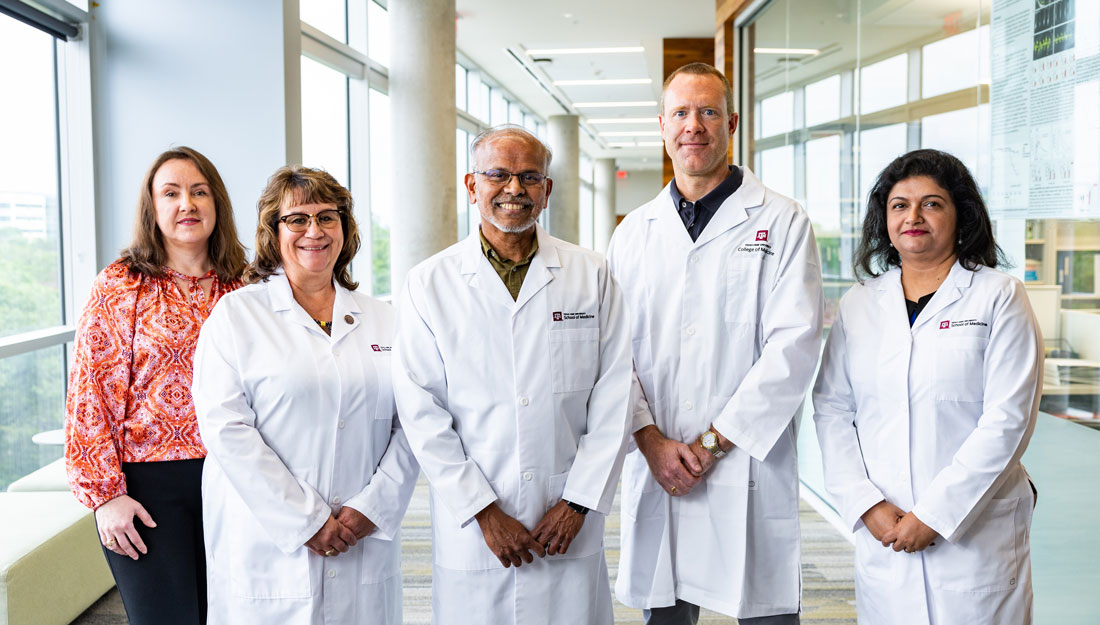- Sunitha Konatham
- Medicine, Research, Show on VR homepage
School of Medicine receives nation’s first NIH lymphatic biology training grant
Funding will be used to train the next generation of lymphatic system researchers, opening a new avenue for exploring disease processes and potential treatments

The new LYMPH Training Program at the Texas A&M School of Medicine is led by (from left) administrative manager Oksana Nekrashevych, curriculum co-director Shannon Glaser, program director Mariappan Muthuchamy, program co-director Brett Mitchell and curriculum director Sanjukta Chakraborty. (Cameron Johnson / Texas A&M Health)
The Texas A&M University School of Medicine has become the first institution in the country to be awarded a National Institutes of Health (NIH) training grant specifically targeting lymphatic biology and medicine. The NIH’s National Heart, Lung, and Blood Institute awarded funds to the School of Medicine for two PhD students per year selected for the LYMphatics in Pathology and Health (LYMPH) Training Program. This prestigious award will be used to train the next generation of lymphatic biologists in pursuit of a deeper understanding of the molecular mechanisms, physiological systems and clinical applications of lymphatic research.
This training grant is the first of its kind in the nation, as lymphatic biology is a relatively new field of study in medicine, and is now gaining traction as an area of special interest by the NIH. It has been historically underfunded despite playing a central role in many of the body’s processes, including fluid balance, immune function and waste removal, which collectively involve every organ system in the body. This means the lymphatic system is another avenue by which scientists can research disease processes and identify potential treatments.
To better understand the intersection of the lymphatic system with other processes in the body, as well as gain perspective from a variety of disciplines, the students in the LYMPH training program will have the opportunity to be taught and mentored by faculty members from four School of Medicine departments (Medical Physiology, Microbial Pathogenesis and Immunology, Neuroscience and Experimental Therapeutics, and Translational Medical Sciences), the biomedical and chemical engineering departments in the College of Engineering, and the Veterinary Physiology and Pharmacology department in the School of Veterinary Medicine & Biomedical Sciences.
Texas A&M has long been at the forefront of lymphatic research, dating back to the early 1990s when Harris J. Granger, PhD, and David C. Zawieja, PhD, identified the importance of the lymphatic system and began researching lymphatic physiology principles and concepts. Zawieja founded the Division of Lymphatic Biology within the Cardiovascular Research Institute at Texas A&M School of Medicine in 2003 to expand the lymphatic research program.
Mariappan Muthuchamy, PhD, was one of the four primary faculty at the inception of the Division of Lymphatic Biology. Although he started as a cardiac molecular physiology researcher, he and Zawieja, who is now the chair of the Department of Medical Physiology, collaborated to understand how the contractile function of cardiac muscle cells and lymphatic cells may be related. Years later, they determined that the lymphatic cells had both cardiac and smooth muscle contractile elements and coined the term “lymphatic muscle cells.” This term is now used throughout the lymphatic research community and their original publication continues to be cited to this day.
With the desire to train more lymphatic biologists and grow the field, Zawieja and Muthuchamy began working on an NIH grant application back in 2015. Over this almost decade-long journey, Muthuchamy says he learned that the keys to a successful grant-funded training program are an established group of faculty members who share a common passion for training graduate students, a strong record of training students in a particular field of study, and the backing of the institution. The LYMPH Training Program boasts all three of these components, with 23 faculty members from Texas A&M University who will be involved in the education and mentoring of the trainees, 18 alumni who have been trained in lymphatic biology in the Department of Medical Physiology, and enthusiastic support from School of Medicine Dean Amy Waer, MD, and the school’s leadership team.
“Every scientific field has its ups and downs in terms of funding and relevance,” Muthuchamy said. “The congressional vote to establish an NIH National Commission on Lymphatic Diseases (NCLD) in 2022 is a promising sign that this is one of the highest peaks for lymphatic research.”
Muthuchamy will now serve as the LYMPH Training Program director, along with Brett Mitchell, PhD, the program’s Co-Director, Sanjukta Chakraborty, PhD, and Shannon Glaser, PhD, in-charge of the program’s curriculum development, Oksana Nekrashevych, MPH, the program’s administrative manager. He is hopeful that the establishment of the NCLD and the NIH grant funding at Texas A&M are strong steps towards “growing the number of lymphatic biologists, because that is very needed at this time.”
Although Muthuchamy and his collaborators have made incredible strides in lymphatic research, including areas such as metabolic diseases, hypertension, cancer, and amyotrophic lateral sclerosis (Lou Gehrig’s disease), he says “there are still a lot of unanswered questions and a lot of room for potential discovery.” He hopes to have more people join the field of lymphatic biology to grow the potential for discoveries in medicine and is excited for the opportunity to gain new collaborators and foster more innovative perspectives to the field as a result of this new NIH grant.
Media contact: media@tamu.edu


